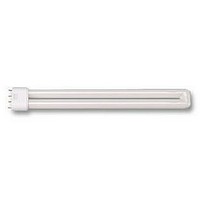DL5584 OSRAM, DL5584 Datasheet - Page 50

DL5584
Manufacturer Part Number
DL5584
Description
LAMP, DULUX, L, CW, 55W
Manufacturer
OSRAM
Datasheet
1.DD1082.pdf
(82 pages)
Specifications of DL5584
Supply Voltage
101V
Base Type
4 Pin
Power Rating
55W
Luminous Flux
4800lm
Length
533mm
Colour Temperature Typ
4000K
Svhc
No SVHC (15-Dec-2010)
Colour
Cool White
External Diameter
17.5mm
External
RoHS Compliant
Lamp Base Type
4 Pin
Rohs Compliant
Yes
Bulb Diameter
17.5mm
Economical long-life light sources with plug-in bases.
Compact Fluorescent Lamps OSRAM DULUX
Technical Guide
4.6.4 Operation at high
4.6.5 Operation at low
temperatures
temperatures
On conventional linear fluorescent lamps, the cold spot is normally in the centre of
the lamp. Additionally the luminaire will generally have a large radiating surface
which will ensure moderate tube wall temperatures and high efficiency. In contrast
to linear fluorescent lamps, compact fluorescent lamps are much shorter despite
having high lamp wattages. There is therefore a tendency to make luminaires as
small as possible. Often the thermal characteristics are ignored.
In particularly small enclosed luminaire systems the temperatures at the points on nor-
mal OSRAM DULUX
that luminous flux and therefore the efficiency of the luminaire are reduced appreciably.
Because in such cases the lamps are no longer operated at their optimum
there are also changes in the electrical values of the lamp (reduced lamp
power) at high ambient temperatures, which in turn will impair the control
gear and shorten the life of the lamp. It is important therefore to take into
consideration the maximum temperatures permitted on the lamp (see 4.8).
At high ambient temperatures, at which conventional OSRAM DULUX
be operated at their optimum (reduced luminous flux), it makes sense to use OSRAM
DULUX
their optimum mercury vapour pressure at a high lamp ambient temperature, amalgam
lamps operate at their optimum efficiency under the same conditions in narrow lumi-
naires and therefore achieve a higher lamp power.
All the electrical and photometric values (lamp current, lamp voltage and luminous
flux) relate to the higher lamp output. In narrow luminaires equipped with OSRAM
DULUX
OSRAM DULUX
ring point and must be taken into consideration when designing the luminaires. The
maximum permitted temperature at the IEC measuring point is 140 ºC (measuring
point 1, see 4.8).
The following points must be taken into account when operating OSRAM DULUX
lamps on CCGs and ECGs at low temperatures:
1. The lamp must be capable of starting at the required temperature.
2. After ignition, the tube wall must warm up sufficiently for the lamp to operate
The low ambient temperatures at which OSRAM DULUX
junction with conventional control gear are shown in 4.2. If operated with appropriate
electronic control gear, OSRAM DULUX
even lower temperatures.
In low-temperature applications, the lamps should be used only in enclosed lumi-
naires. It is important for the volume of the luminaire to be such that the lamp(s) can
warm up rapidly so that ambient temperatures at which the lamps will operate
efficiently are reached within a short time. If there are considerable fluctuations in
temperature, the luminous flux/temperature curves for the different burning positions
should be studied in order to arrive at a suitable compromise between lamp and
luminaire efficiency.
OSRAM DULUX
models, can also be used at low temperatures in luminaires of suitable dimensions.
However, they will take longer to reach their full luminous flux.
within its optimum range
®
®
IN amalgam lamps to achieve maximum luminous flux. Since they achieve
IN lamps, there is therefore more heat released than is the case with normal
®
®
lamps. This leads to an increase in temperature at the IEC measu-
T/E IN lamps (amalgam lamps), particularly the high-wattage
®
®
lamps that have a major influence on luminous flux are so high
®
lamps with four-pin bases can ignite at
®
4. Operating characteristics
will ignite reliably in con-
®
lamps cannot
®
49











